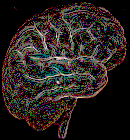


YOUR LEFT BRAIN
processes data as
cat
YOUR RIGHT BRAIN 
processes data as

|
INTRO
Have you ever wanted to unlock the brainpower you once
had? The sort of learning abilities that you once had as
a young child... Some theorists say we learn more during
the first five years of our life than we do for the next
fifty; as we progressively use less of our three
"thinking brains". top
3 BRAINS
To find out where your three "thinking brains"
are, place your forefingers under each earlobe. The part
of your brain between your fingers is the non-thinker
autopilot brain-stem, which is responsible for basic life
support such as breathing and respiration. Now place your
fingers on top of your ears. This part of your thinking
brain is the limbic system, which tends to be responsible
for our emotional and survival behaviours. This brain
houses the four "f areas"; fighting fear,
feeding and sexual reproduction.
If you were to now place your forefingers on top your
head (like antennas) you would locate the left and right
thinking hemispheres of your neo-cortex. While both
hemispheres are in constant communication, for most
people the left hemisphere is responsible for; language,
analysis, counting, reading, writing, talking, logic,
thinking one thought at a time and controlling the right
side of the body. The right hemisphere is non-verbal,
(intuitive) visual, creative, spatial, musical, thinks
thoughts simultaneously and operates the left side of the
body. Whilst it's often called 'grey matter' a living
brain is actually colored pink by blood. My hand shows
the actual size of the right side of your brain. top
KIDS
VS. ADULTS
Unfortunately, there is an ever-increasing emphasis on
teaching the "left-brain" 3R skills of reading
'riting 'rithmetic rather than 'whole-brain' thinking. As
young children we were fascinated and excited by
learning, and as a result, we used more of our limbic
system. (It's easy to remember what you enjoy and are
emotionally involved with.) We were also much more:
imaginative; musical; curious; and visual; -all right
brain functions.
While adults tend to contemplate life via symbols such as
numbers and letters, young children contemplate
"reality". If I initially mention
"four" or "cat" to my adult students,
they usually process it as "4 or four" and the
word "cat". A young child would think of
"::" and an image of a cat. As our memories are
predominantly visual, it's natural that sixty per cent of
young children have memories that are almost eidetic or
"photographic". Unfortunately, through lack of
stimulation, only about ten per cent of adults have a
similar memory capability!
Most young children
learn rapidly, with a sense of excitement and whole brain
stimulation. The early school years are facilitated by:
art; rhymes; music; and picture books. Then as the
"right-brain" becomes increasingly dormant,
often the only time we engage in right-brain thinking is
when we are distracted by "innermusic" and
day-dreams. top
|
 |
TIME
SHIFT
At night, when the sun has set and the stars come out, we
become right-brain dominant and experience hours of
creative visual thinking.
Upon
waking, as the stars fade, our bossy verbal left brain
takes over, shuts down our right-brain, we forget our
dreams, and lose our ability to generate visual imagery
and have flashes of inspiration. Interestingly,
ninety-five per cent of scientific breakthroughs occur
when people have access to their creative right-brain
thinking. Einstein, for example, trusted and applied his
imagination to every discovery he made. After freeing his
right-brain to daydream, he would then use the maths of
this left-brain to prove true the theories he had
"imagined" when relaxed!
You may be familiar with Newton discovering
"gravity" while sitting under a tree with his
apple, or Archimedes jumping out of his bathtub yelling
"Eureka!", having solved another complex
problem. No doubt you've occasionally been brilliant
while dozing, under the shower, or on the toilet, only to
lose that inspirational thought as your judgmental
left-brain re-asserts itself. Quite soon you'll be able
to be creative and experience flashes of inspiration
during the day. Also, you will soon have the
"guts" to go with your gut feelings or
right-brain thinking! top
|







